Construction and application of bioinspired nanochannels based on two-dimensional materials
Jinlin Hao, Weijie Wang, Jiawei Zhao, Honglin Che, Lu Chen, Xin Sui
College of Materials Science and Engineering, Qingdao University, Qingdao 266071, China
Keywords:Bioinspired nanochannels 2D material Layered structure Energy conversion Responsive nanochannels
ABSTRACT With the development of nanotechnology and materials science, bioinspired nanochannels appeared by mimicking the intelligent functions of biological ion channels.They have attracted a great deal of attention in recent years due to their controllable structure and tunable chemical properties.Inspired by the layered microstructure of nacre, 2D layered materials as excellent matrix material of nanochannel come into our field of vision.Bionic nanochannels based on 2D materials have the advantages of facile preparation, tunable channel size and length, easy expansion, and modification, etc.Therefore, the 2D layered nanofluid system based on bionic nanochannels from 2D layered materials has great potential in biomimetic microsensors, membrane separations, energy conversion, and so on.In this paper, we focus on the construction and application of bionic nanochannels based on 2D layer materials.First, a basic understanding of nanochannels based on 2D materials is briefly introduced, we also present the property of the 2D materials and construction strategies of bionic nanochannels.Subsequently, the application of these nanochannels in responsive channels and energy conversion is discussed.The unsolved challenges and prospects of 2D materials-based nanochannels are proposed in the end.
1.Introduction
Biological ion channels on the cell membrane of organisms can control the transportation of ions and molecules across the membrane to complete the communication with the outside of the cell to achieve inter-cell signal transmission, energy transfer, and maintain the normal physiological function [1–4].For example, potassium ion channels on the membrane of nerve fibers in animals can convert various stimuli into electrical signals [5]; proton channels on the retina can convert solar energy into bioelectricity [6]; calcium ion channels on the membrane of the heart muscle can maintain biological potential [7]; electric eel contains a large number of electrocyte with ion-selective channels and is able to convert the salinity gradient energy inside and outside the cell into bioelectricity, generating action potential as high as 600 V for hunting or self-defense [8–10].With the development of nanotechnology and materials science, bioinspired nanochannels appeared by mimicking these intelligent functions of biological ion channels [11–17].Bioinspired nanochannels can reproduce the rectifying, gating, energy transfer, and stimuli-responsive functions in organisms [18–20].Based on these bioinspired functions, researchers boost a lot of related applications such as biomimetic microsensors, biomedical analysis, membrane separations, seawater desalination, energy conversion [18,21-26].For bioinspired nanochannels, the surface chemistry and geometry of channels should be controlled to manipulate the ion transport performances.The length scale of these nanochannels needs to be down to 1–100 nm in one dimension[27,28].In addition, the transport of the nanochannels is mainly determined through the surface chemistry of the channel walls,leading to diverse unique phenomena of transport [29].
Over recent decades, numerous investigations have been allocated to the construction and application of bioinspired nanochannels.Guoet al.by using abiotic materials, synthesized a PET singlepore nanometer ion channel, obtaining maximum efficiency power of 26 pW within a salinity gradient energy [30].Regarding the sensitive detection mechanism of CO2in mice and the action mechanism of heme as a channel inhibitor, our group designed CO and CO2responsive ion channels based on PET single pore membrane [31,32].Fundamental researches in these single-pores can substantially facilitate the development of nanoporous membrane smart systems.In recent years, carbon nanotubes (CNTs) [33], inorganic nanowires [34], organic nanofibers [35],etc.based on onedimensional (1D) nanomaterials can assembly into macroscopic nanochannels membrane as nanofluid systems, gaining considerable attention [36–38].Furthermore, various three-dimensional(3D) nanomaterials including hydrogels, inorganic mica flakes, and polymer films,etc.[39,40] have been broadly applied for constructing bionic nanochannels.can simply type your text into this template or modify an already prepared manuscript based on the template formating.
Nacre microstructure is described as a “brick and mortar”layered arrangement, the interstitial space between opposite nanosheets could be processed as lamellar channels for the transport of charge and mass [41].These layered structures can enhance the ion migration density, and can substantially diminish the ion migration resistance, and possesses the control feature of the surface charge on the nanometer scale.In addition, this natural structure plays an important role in its mechanical properties.This provides a source of biological inspiration for researchers to build biomimetic nanochannels with practical applications.Inspired by nacre-liked layered materials, two-dimensional (2D) layered nanomaterials have attracted our attention, such as graphene oxide (GO) [42,43], MXene [44,45], black phosphorus (BP) [46],MoS2[47,48], C3N4[49], nano-clay [50,51].Bionic nanochannels based on 2D nanomaterials have significant advantages:(1) The preparation methods of 2D layered nanomaterials are facile.For example, it can be realized by vacuum filtration.Such as GO membranes, after pouring the prepared GO dispersion into a vacuum filter device, GO membranes with layered structure can be formed after simple vacuum filtration [52].(2) The channel size and length of 2D layered nanochannels could be easily controlled by changing the conditions of the dispersion solution.(3) The basic components of 2D nanomaterials can be modified efficiently in their dispersions.For instance, an anion-selective GO film was prepared by modifying the GO dispersion to make it positively charged [53].In this review, we introduced the latest progress in the construction of 2D materials-based bioinspired nanochannels, including various 2D nanomaterials like GO, BP, MXene, MoS2, nano-clay, C3N4,MOFs and preparation methods like vacuum filtration, evaporation,pressure-assisted pumping, wet-spinning assembly, chemical vapor deposition, electron irradiation.These nanochannels based on 2D materials can be used in responsive nanochannels, biomimetic sensing, separation and filtration, biomedical analysis, energy conversion,etc.In this paper, we mainly summarize the wide application of responsive nanochannel and energy conversion (Fig.1).Finally, we present some of the challenges that need to be faced in the current research process and the outlook for the future development of this field.
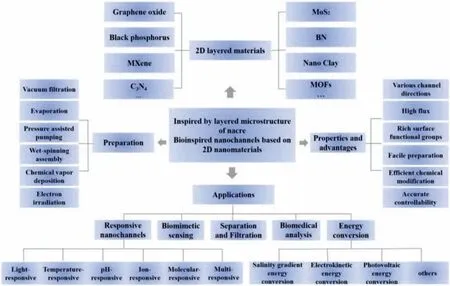
Fig.1.Diagram of construction and application of bioinspired nanochannel membranes based on 2D materials.
2.Design and construction of nanochannels based on 2D materials
2.1.The 2D layered materials for nanochannels
In recent years, 2D materials have been considerably developed for constructing nanochannel membranes.2D materials are generally classified into the following categories:single-element 2D materials [54–57], transition metal sulfide [47,48,58,59], layered silicate materials [50,51], novel 2D materials [60–62] and other 2D materials [63].2D material was proposed with the Geim’s group at the University of Manchester in 2004 for successful isolation of single-atom layers of graphite material-graphene [64].Graphene,with single-atom layer thickness and high strength, whether in theoretical research or application fields, has aroused great interest, and it is also the earliest widely used 2D material utilized for constructing bionic nanochannels (Fig.2a) [53].Graphene and its derivatives, especially GO, have excellent modifiable sites such as hydroxyl and carboxyl.It can be modified with specific molecules to mimic receptor-based specific adsorption or selective transport of specific ions on the membranes of nerve cells.BP is another type of single-element 2D material, and its properties and structure are similar to graphite [65].Furthermore, it can be peeled off.The stripped BP will be oxidized when exposed to air and water.BP is the most stable allotrope in phosphorus elements.It has become a new material for the preparation of layered nanochannels.Zhanget al.stripped BP and conducted controlled oxidation in water to produce charged phosphorus compounds.Then, they reconstructed the nanosheets as layered nanochannels for ion transport (Fig.2b) [46].Transition metal disulfide compounds are a major branch of 2D materials.These materials generally exhibit a sandwich structure of X-M-X, and the layers are connected by van der Waals forces, showing obvious anisotropy.Radenovicet al.utilized molybdenum disulfide(MoS2) to construct nanochannel and demonstrated more desirable water-transport performance in comparison to graphene because of the enriched hydrophilic surface sites [47].TMDs can be prepared for atomically thin nanopore membranes.Ultrathin nanopore membranes are considered an approach to achieve rapid and cheap DNA sequencing.Compared with traditional silicon nitride nanopore with thickness of about tens nanometers, it performs better sensitivity [66].Montmorillonite (MMT), a naturally occurring silicate mineral, is a kind of earth-like mineral composed of nanometer-thick negatively charged silicate sheets that are stacked together by electrostatic interaction between the layers [67,68].The average thickness of the wafer is less than 25 nm after stripping and dispersing, purification and modification, ultrafine grading, and special organic composite (Fig.2c) [69].It has very strong adsorption capacity and cation exchange performance,and low cost.Kaolin is another layered silicate substance, which is the most abundant in soil [70].The difference between MMT and kaolin lies in the spatial structure [71].Kaolin is an aqueous aluminosilicate with no cations or water molecules between the structural layers and strong hydrogen bonds (O-strengthen the bonds between the structural layers) (Fig.2d) [72].However, montmorillonite is a silicate clay mineral with a lamellar structure and lamellar crystallization.There are cations or water molecules between the structural layers.The strong oxygen ion chain strengthens the connection between the structural layers.They are the appropriate layered materials for nanochannels.

Fig.2.The layered materials for nanochannel membranes.(a) GO layered membrane, first proposed 2D material.Reproduced with permission [53].Copyright 2017,John Wiley & Sons.(b) BP membrane prepared by stripping nanosheets.Reproduced with permission [46].Copyright 2020, National Academy of Sciences.(c) MMT, composed of nanometer-thick negatively charged silicate sheets.Reproduced with permission [69].Copyright 2020, Elsevier B.V.(d) Modified and reconstructed kaolin base membrane.Reproduced with permission [72].Copyright 2017, John Wiley &Sons.(e) MXene membrane, a new 2D material.Reproduced with permission [73].Copyright 2019, Springer Nature.(f) MOFs porous materials.Reproduced with permission [80] Copyright 2018, Elsevier B.V.
As new 2D material, the appearance of MXene attracted great attention [45,61,73-75].MXene is a category of 2D inorganic compounds in materials science.These materials consist of transition metal carbides, nitrides, or carbonitrides several atomic layers thick.The hydrophilic surface of delaminated MXene nanosheets possesses plenty of the sites of Lewis acid Ti as well as hydroxyl groups that are able to behave as charged units, which considerably simplify the confined transport of ions and water.Zhanget al.utilized MXenes and their composites to explore the transmission of ions.The layered membranes have remarkable strength and marvelous stability (Fig.2e) [73].MXenes, with its unique structure and physical properties, are widely used in the field of energy conversion and storage.Actually, they also hold potential in biochannels such as biosensing by surface functionalizing with polymers or nanoparticles.They have large specific surface area and high conductivity, and can be used as immobilized substrates for proteins, enzymes and bioluminescent materials, improving the sensing sensitivity and reducing the detection limit [76,77].Metalorganic frameworks (MOFs) as 2D material are a new class of crystalline porous materials with periodic 2D structures formed by the self-assembly of bridged organic ligands and inorganic metal centers.MOFs possess various suitable features including large specific surface area, porosity, and polymetallic sites, so they are widely used in catalysis, molecular separation, slow release of drugs, energy conversion, and other fields [78,79].Zhai and coworkers illustrated a number of hybrid nanochannel membranes through the incorporation of MOFs/polymer composites with anodic aluminum oxide as hybrid nanochannel membranes, attaining outstanding energy conversion behavior.(Fig.2f) [80].In addition, other 2D materials such as carbon nitride (C3N4) and boron nitride (BN) have also been developed as appropriate 2D materials for constructing nanochannel membranes [49,81].
2.2.Preparation of bioinspired nanochannels based on 2D materials
The preparation method of bionic nanochannels based on 2D nanomaterials is relatively facile compared with other materials[82].The original materials can be reassembled into a layered structure through a strip-recombination strategy [83,84], and the gaps between the reconstructed layered materials can be used as nanochannels for ion transmission [85].Vacuum filtration is the most common technique for the synthesis of 2D nanochannels:(1) it is simple and economical; (2) the distance between the layers and the thickness of the membrane could be controlled.For instance, Huanget al.attempted to prepare GO layered bionic nanochannel system by simple vacuum filtration [52].Subsequently, the bionic nanochannel system based on GO has been continuously developed and studied as it can be modified with more possibilities.Liuet al.prepared the MXene membrane by vacuum filtration.The prepared MXene dispersion was filtered through a vacuum onto a polycarbonate membrane [61].The dispersed MXene nanosheets self-assembled into a lamellar membrane material that could be easily peeled off the polycarbonate membrane.By vacuum filtration, Zhanget al.prepared a freestanding heterostructure membrane based on BP and GO with good flexibility for ion transport.They placed BP dispersed in dimethyl methylamine on a vacuum filter, to develop the GOintercalated BP membrane, the multilayer membrane was synthesized through sequential filtration of BP and GO dispersion.In addition, evaporation-assisted self-assembly and pressure-assisted filtration can also be used to prepare 2D biomimetic nanochannels.Lai and his coworkers compared these several preparation methods and found that the membrane material prepared by pressureassisted filtration was the most orderly, while the membrane material prepared by evaporation-assisted self-assembly was the most chaotic (Fig.3a) [85].It is inevitable that the degree of structure order will affect the properties of the layered membrane.For instance, Yuet al.used MMT/CS composite self-assembly to prepare layered membrane through water evaporation induction [67].However, the 2D materials obtained by this method were inferior to the 2D materials obtained by vacuum filtration in terms of mechanical properties.They proved this conclusion with MMT/CS composite membrane through mechanical property tests.The mechanical properties of the structurally ordered membranes obtained by vacuum filtration are better than those obtained by simple mixing of conventional components.The tensile modulus and ultimate tensile strength of the structured ordered films are 3–5 times and 2–3 times higher than those of the conventional films, respectively.
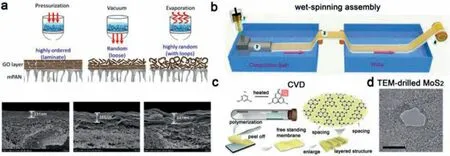
Fig.3.Preparation method of bionic nanochannel materials based on 2D materials.(a) Vacuum filtration, pressure-assisted filtration, and evaporation-assisted self-assembly.Reproduced with permission [85].Copyright 2015, Elsevier B.V.(b) Wet-spinning assembly for construction membrane.Reproduced with permission [86].Copyright 2014,American Chemical Society.(c) Freestanding polymeric carbon nitride membrane prepared through CVD.Reproduced with permission [87].Copyright 2018, John Wiley &Sons.(d) MoS2 single nanochannel achieved by TEM.Reproduced with permission [47].Copyright 2016, Springer Nature.
In recent years, new methods for preparing 2D nanochannels appear and give us more possibilities.Liuet al.suggested a wetspinning assembly technique for continuous and rapid generation of GO films [86].In the first step, the injection of GO dispersion was executed into a coagulation bath by using a spinning channel.Subsequently, the GO dispersion was transformed into wet films through coagulation, and concurrently on a PET film was supported.The generated GO film can be 15 centimeter-wide and 20 meter-long (Fig.3b).Xiao and colleagues presented the creation of 2D ultrathin-free-standing polymeric carbon nitride membranes that could be utilized for processing of ions transportation due to the peculiar layered structures.The process of fabrication is accomplishedviachemical vapor deposition (CVD) or vapor-deposition polymerization (VDP).The membrane of polymeric carbon nitride could be simply delaminated from the glass substrates without causing any damage through soaking with water, already exhibiting the porosity (Fig.3c) [87].The application of 2D nanomaterials for generating single pore nanochannels has also been reported.For instance, Fenget al.synthesized a monolayer of MoS2single nanochannel for transport of ions by taking advantage of the techniques of electron microscopy drilling (Fig.3d) [47].This nanochannel possesses the enrichment of hydrophilic surface points, indicating more desirable water transport capacity compared with GO.Despite the fact that the practical application of single pore membranes is difficult, it lays a foundation for the establishment of the basic mechanism of ion transport.
2.3.Properties of nanochannels based on 2D materials
2D materials can be used for constructing single nanopore,porous nanochannels, and hybrid nanochannels.For a single nanopore, it can be obtained by etching the pore channels on a single layer of nanosheets.This ion transport is not affected by the interactions between channels It has the shortest ion transport path, the lowest membrane resistance (Fig.4a) [47].Nanotube with smooth inner walls can also be used as an ion transport channel,which can carry functional groups on the surface for selective ion transport.Bocquetet al.reported a boron nitride single nanotube(BNNT) nanofluid device, which consists of a single nanotube with a diameter of 15~40 nm and a micron-size length (Fig.4b) [63].The device was prepared by careful manipulation of embedding and sealed in a silicon nitride film under a scanning electron microscope.
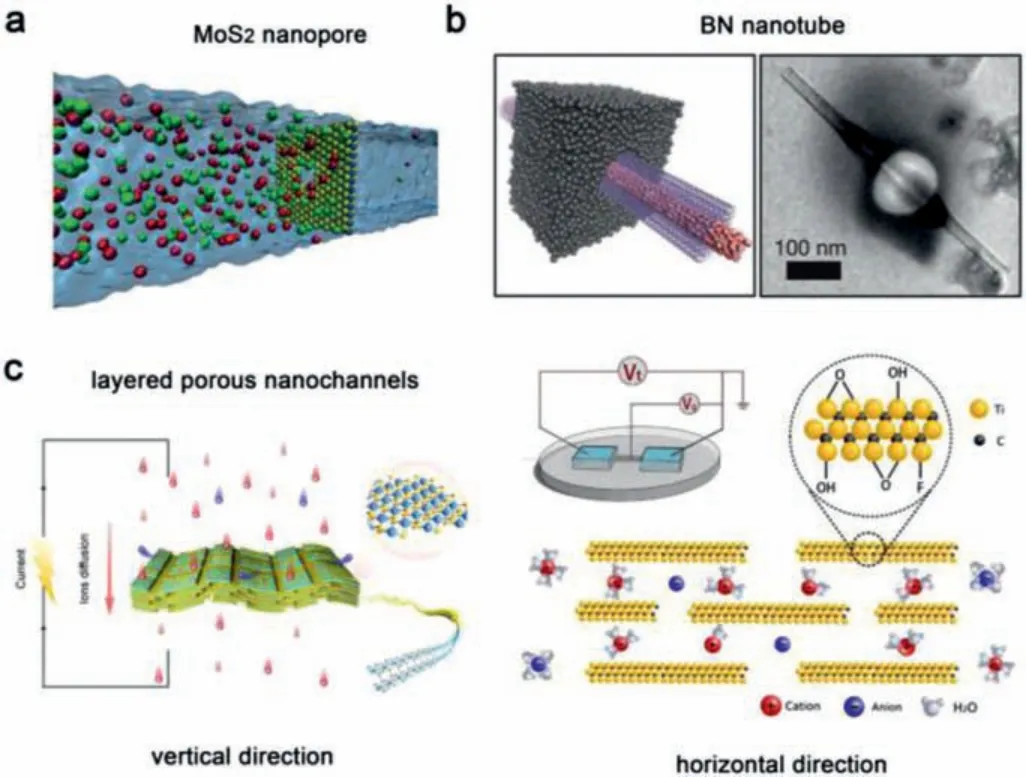
Fig.4.Various channel directions of bionic nanochannels based on 2D materials.(a) Single nanopore achieved by TEM used for ion transport.Reproduced with permission [47].Copyright 2016, Springer Nature.(b) Nanotube with smooth inner walls used as an ion transport channel.Reproduced with permission [63].Copyright 2013, Springer Nature.(c) The vertical and horizontal direction of layered nanochannels for ion transport.Reproduced with permission [48,62].Copyright 2021, American Chemical Society.Copyright 2019, American Chemical Society.
For porous nanochannels, based on the unique lamellar stacked structure of 2D biomimetic nanochannel materials, the migration modes of ions are more abundant.The diffusion direction of ions from the 2D nanochannel material plane is usually vertically through the interlayer space (Fig.4c) [48].In recent years,2D layered materials have been constantly explored in the field of vertically ion transport, such as nanochannels based on graphene,boron nitride, BP, MXene, transition metal disulfide compounds,silicate compounds.For example, Zhuet al.demonstrated that composite membranes made of 2D metal MoS2are not only robust and stable but also that the high electron density of MoS2can increase the surface affinity of cations, which shows good ion selectivity and high ions flux and promotes the transmembrane ion migration [48].In addition, 2D layered materials can also enable ion transport horizontally (Fig.4c) [62].We can use a 2D cross-section parallel as an ion channel in the sandwich space for ion transport.Wang and his coworkers used vacuum filter MXene dispersible solution on anodic alumina membrane to produce a hybrid membrane with an ordered layered structure.Then, the hybrid membrane was embedded in PDMS elastomer to produce an ion channel material that is parallel to the sandwich space.For both directions, the ion transport characteristics are influenced by the features of the surface related to the reassembled 2D nanosheets.The narrow distance of the interlayer has about 1 nm wide, and the electrical double layer (EDL) has completely covered the lamellar fluidic channels correlated well with the charge of the surface, resulted in the transport of unipolar ions.In such circumstances, the counter-ions are the only charge carriers, because the co-ions are fully expelled from the 2D nanochannels.In comparison to the horizontal transport mode, the charge and mass transport in the vertical direction permits high-performance membrane-based functionalities, specifically when the thickness of membranes could be diminished to multiple nanometers.2D materials can also be used for constructing hybrid membranes to achieve high ion transport properties and more functionality.In these membranes, the path of ion transport will be more diversified, they will combine 2D-based nanochannels and other materials.
3.Applications
3.1.Responsive nanochannels based on 2D nanomaterials
The leading characteristic of biological ion channels for smart monitoring of the cellular surroundings is the responsive transport of ions under external stimuli which plays a pivotal role in various biological applications, including visual sense and neuronal excitations [88–90].Inspired by the structure and function of biological ion channels, biomimetic responsive nanochannels based on 2D nanomaterials for ion transport have attracted a lot of attention in recent years [91,92].Bioinspired nanochannels can be used to create a variety of nano-devices that respond to external stimuli and control the opening or closing of ion channels.Such as light, pH,temperature, multiple stimuli simultaneously and specific ions or molecules.
Due to the limitation of carrier migration and heat diffusion in the 2D plane, 2D materials exhibit many unique features, and their adjustable bandgap is widely used in photoelectric devices, fieldeffect tubes, thermoelectric devices, and other related fields [93–95].Directional migration of ions controlled by light has aroused great interest in the interdisciplinary direction.For example, MXenes, which organize a category of highly-developed materials for photothermal conversion with potent light absorption and efficacious photothermal conversion, were applied for efficient conversion of light into heat [96,97].Liuet al.exhibited a modern mechanism of nanofluidic regulation on the basis of the phenomena of heat-driven light-induced active ion transportvialamellar Mxene membranes [61].Owing to the considerable light-induced heat impact, a temperature gradient emerges immediately after illumination is employed to an off-center position, inducing an actively temperature gradient-driven transport of ionic species.Xiaoet al.explained a light-induced ion pump strategy on the basis of the commonly used membranes in which the nanotubes are created from the coating of cylindrical nanochannels with carbon nitride.The separation of holes and electrons in carbon nitride nanotubebased membranes (CNNM) under illumination leads to a transmembrane potential which is considered as the key of pumping phenomena, owing to the potent light absorption capability of carbon nitride-based semiconductors and photocatalysts (Fig.5a)[49].In molybdenum disulfide (MoS2)-based membranes, single nanopores have indicated record-high power efficiencies in alkaline circumstances.Through enhancing the charge of the surface within MoS2membranesvialight, Radenovicet al.doubled the osmotic power produced through a single nanopore at a neutral pH [98].The single-layer transition-metal dichalcogenide has been found very interesting for optoelectronics functionalities due to the presence of a visible range direct bandgap.Further, light has been utilized to ameliorate directional ion migration by enhancing the intensity of light to induced surface charges.This mechanism is usually achieved by modifying photo-responsive molecules.Guoet al.generated a photo-responsive nanofluidic diode on the basis of chemically modified GO membranes [99].The process of modification was completely straightforward and simple.The solution of ethanol relevant to photoactive molecules, spiropyran,was dropped on the upper surface of a fragment of the GO membrane.Next, the moieties of spiropyran were permeated into the GO membrane and adsorbed on the upper surface layers of the GO membrane, through interactions ofπ-π.Upon the irradiation of UV, the conversion of spiropyran to the cationic merocyanine was carried out, enhancing the membrane the ion-selectivity (Fig.5b).Kimet al.used layer-by-layer assembly strategy to assemble GO membranes from GO and amine functionalized GO.The GO multilayered membrane owned pH tunable thickness, roughness, and charge density as the electric charge effect [100].
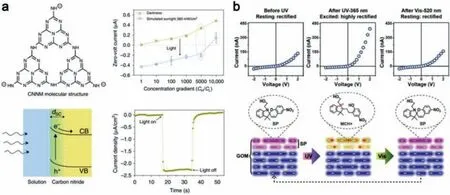
Fig.5.(a) Light responsive carbon nitride nanotube membrane.Reproduced with permission [49].Copyright 2019, Springer Nature.(b) Photo-responsive nanofluidic prepared by spiropyran modified GO.Reproduced with permission [99].Copyright 2020, Royal Society of Chemistry.
In addition, thermal-responsive molecules have been also widely used in building responsive nanochannels.Poly(Nisopropylacrylamide) (pNIPAM) and poly(sulfobetaine), typical temperature responsive polymers, often can be modified onto nanochannels as a functional molecule [101–104].Kunget al.grafed poly(sulfobetaine) onto GO sheets to construct a thermally responsive membrane [105].It showed an upper-critical solution temperature (UCST) type response in organic electrolytes as the transformation of the morphology of polymer chains.Due to the changing of temperature, the polymer chains will coil or uncoil to promote or hinder the transport of ions.Besides introduce temperature-responsive molecules, Wuet al.explored a nonlinear thermal responsive nanodevice through incorporating GO nanosheets and cellulose nanofibers (CNFs) assembled membrane with considerable space charge and enlarged nanochannels [106].Owing to the bubble nucleation, the hybrid membrane exhibits a nonlinear thermal dependence relationship at greater temperatures.Fuet al.explored the thermal response principle of 2D material ReS2[107].The ReS2nanosheet demonstrated out-ofplane bending with enhancing temperature.The intrinsic ripples in ReS2tend to aggregate quickly with enhancing temperature because of the thermal fluctuations.The weak interlayer coupling of ReS2is further weakened, resulting in interlayer sliding.
Nanochannels on the basis of 2D materials have been broadly employed in molecular recognition and sieving [108,109].Nair and colleagues utilized GO membrane to obtain meticulous and ultrafast molecular sieving [110].According to their achievements, the tiny species were able to permeate with almost the same speed,whilst larger ions and organic molecules illustrate no detectable permeation (Fig.6a).Miet al.scrutinized the transmission path of ions and molecules in the GO membrane and the adjustability of the size of nanochannels [111].GO membranes demonstrate the next generation of ultrathin, high-flux, and energy-efficient membranes for meticulous ionic and molecular sieving (Fig.6b).In addition to molecular sieving by channel size, GO membranes can be modified with specific polypeptides for the recognition and transporting of specific ions (Fig.6c) [112].

Fig.6.(a) Ion seiving through GO membrane.Reproduced with permission [110].Copyright 2014, American Association for the Advancement of Science.(b) A diagram of transport of ions and molecules in GO membrane with adjustable channel size.Reproduced with permission [111].Copyright 2014, American Association for the Advancement of Science.(c) GO membrane modified with a peptide that can selective recognition and transport of Co2+.Reproduced with permission [112].Copyright 2015, American Chemical Society.
3.2.Nanochannels based on 2D materials for energy conversion
The development and utilization of sustainable clean energy is still an urgent issue in recent years.Energy conversion membrane has become increasingly important for the development of new sources of energy.In nature, some organisms are considerably skillful in converting clean energy in the environment into bioelectricity.As an example, electrical eels are able to generate strong electric shocks by using a number of membrane-protein regulated ion transport.Inspired by this, nanofluidics based on 2D materials have been created for the conversion of energy [113].
3.2.1.Salinity gradient energy conversion
There is a significant quantity of Marine energy available in nature and salinity gradient energy has considerable potential in reducing the global energy crisis.Salinity gradient energy is a type of green, sustainable clean energy.Pressure retarded osmosis (PRO)and traditional reverse electrodialysis (RED) methods are available for the extraction of energy from the salinity gradients in junction of seawater and river water [114–116].It has been proved by theory and experiment that the reverse electrodialysis method has stronger energy conversion ability [117,118].As the key component of RED technology, the ion exchange membrane (IEM) determines the efficiency and ability of the device in energy conversion [119–122].IEM is embedded in the junction of two solutions with different salinity, and ions can only be transferred through the channels inside the membrane (Fig.7a) [114].Due to the asymmetric transmission of ions, the ion concentration gradient is generated to form an electric field, and this energy is the output to the external circuit through the electrode wire, and then converted into electrical energy.The IEM needs to have the specificity of ion transport and a certain mechanical strength at the same time.2D materials with these properties attract our attention.More and more energy conversion membranes based on 2D materials have been developed for catching salinity gradient energy.
GO membranes have been extensively investigated on salinity gradient power production for decades [123].By taking advantage of reconstructed GO membranes, Sunet al.illustrated a novel approach for salinity gradient power production [124].The ions diffused from the high concentration source side to the lowconcentration drain side driven by the difference in chemical potential.GO nanosheets could be rendered positively charged by the preassembly chemical modification procedure.Whilst negatively charged membranes are able to harvest energy from the flow of unipolar cations, positively charged GO membranes harvests that by using the flow of anions.For example, Jiet al.modified 1-aminopropyl-3-methylimidazolium bromide onto GO membrane to obtain a positively charged reconstructed membrane.In this way, efficient osmotic energy conversion is achieved by containing the opposite charged GO pairs (Fig.7b) [53].In addition,GO membrane also can be applied as a composite membrane in the way blending or assemble.Zhanget al.constructed a heterostructure membrane with GO and BP [46].BP membrane can be oxidated in water to generate more charges.Due to the synergistic effect of GO and BP, the composite membrane achieved high power density of the salinity gradient power generation performance(Fig.7c).
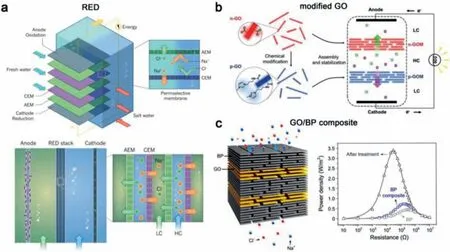
Fig.7.(a) RED technology for harvesting salinity gradient energy and the core component is the ion selective membrane.Reproduced with permission [114].Copyright 2012,Springer Nature.(b) Modified GO membrane for salinity gradient energy conversion.Reproduced with permission [53].Copyright 2017, John Wiley & Sons.(c) Hybrid GO/BP membrane for salinity gradient energy conversion.Reproduced with permission [46].Copyright 2020, National Academy of Sciences.
Salinity gradient energy conversion equipment is located at the junction of sea and river, and the efficiency of energy conversion will also be affected due to the changeable climate in nature.The researchers further explored the influence of external conditions on salinity gradient energy conversion in order to achieve energy conversion devices that are more suitable for practical applications.Temperature changes occur all the time.Inspired by biological thermionic channels, Wuet al.developed MMT/polymer composite cationic nanochannels modified with octa-alkyldimethylammonium bromide (DODAB) application in salinity gradient energy conversion [69].DODAB molecules have different structural shapes at different temperatures to switch on and off ion channels at different temperatures.The output power doubled when the temperature was raised from 30 °C to 60°C.Polyacrylic acid can generate high-density negative charges in the nanochannels, which promote these MMT-based nanochannels have high cationic selectivity (Fig.8a).
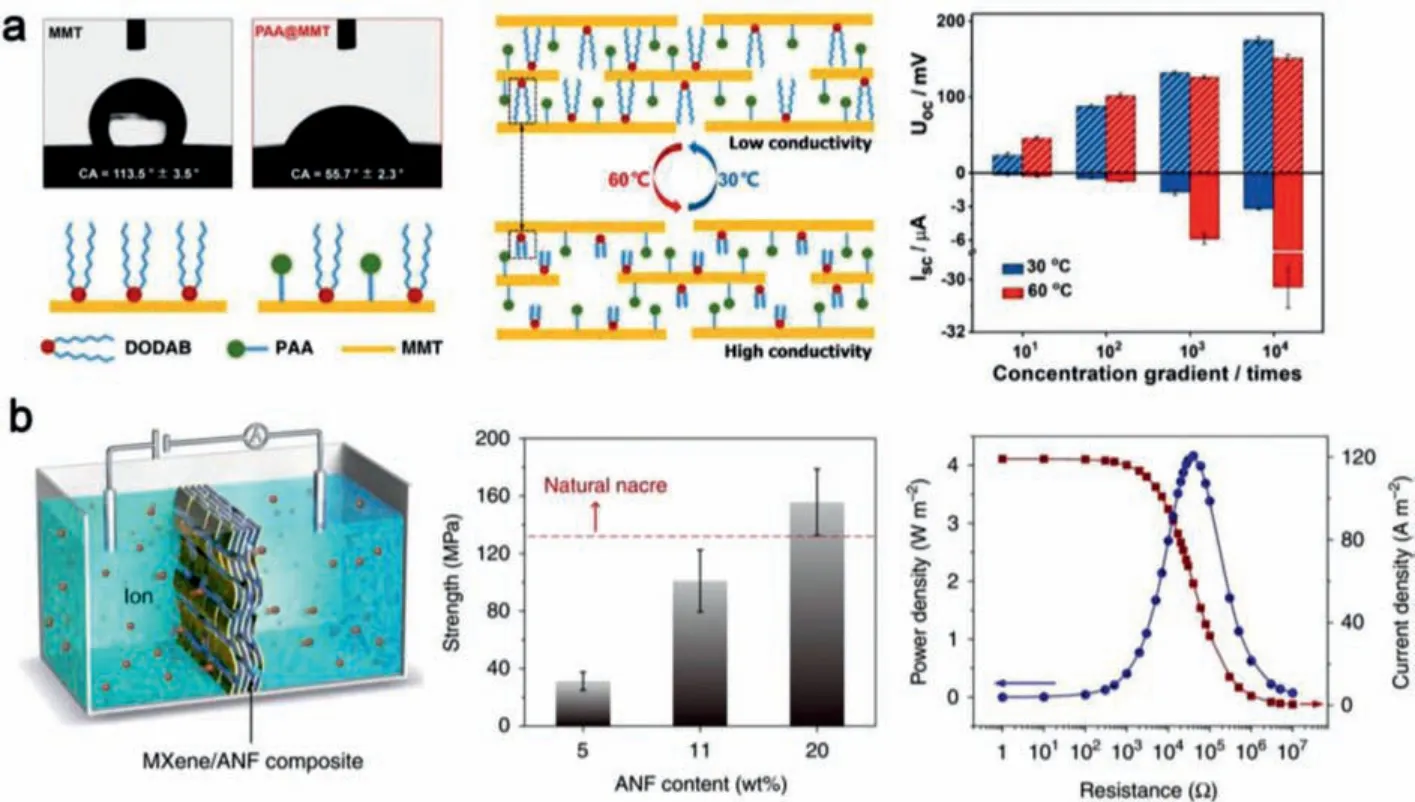
Fig.8.(a) MMT/polymer composite cationic nanochannels with a temperature-responsive molecule for salinity gradient energy conversion.Reproduced with permission [69].Copyright 2020, Elsevier B.V.(b) High strength Kevlar/MXene composite membrane for salinity gradient energy conversion.Reproduced with permission [73].Copyright2019,Springer Nature.
In recent years, as a new 2D nanomaterial, MXene has attracted extensive attention due to its rich surface functional groups and electrical conductivity properties.Honget al.used LiF and HCl to etch Ti3AlC2to obtain MXene nanosheets, then, the orderly accumulation of layers of nanosheets can be realized by vacuumassisted filtration [45].Accordingly, the MXene membrane has outstanding performance in the permeability energy conversion ability [61].Dinget al.modified MXene nanosheets with functional groups to make their surfaces positively charged, and then prepared anionic selective MXene membranes [44].The original negatively charged MXene nanosheets could be self-assembled into cationic selective membrane materials.A larger power density can be obtained by alternately arranging the two layers.This intelligent response applied to biomimetic nanochannels has brought broad prospects for improving the conversion and utilization of salinity gradient energy.In order to break through the bottleneck of 2D material properties (inherent surface properties, layer spacing,etc.), it can be doped with other functional materials in the 2D material.For example, Zhanget al.prepared a high-strength composite membrane by pumping the solution of high-strength Kevlar fiber and MXene solution [73].In addition, the layer spacing was expanded by doping the fiber in the layered nanosheets, and the ion transport performance of the nanochannel was improved obviously (Fig.8b).
As we all know, the thickness of salinity gradient energy conversion membranes has a great influence on their performance.The thickness of these membranes prepared by vacuum filtration is usually in the micron scale.Xiaoet al.prepared an ultra-thin C3N4membrane by vapor deposition method for salinity gradient energy conversion [49].The membrane was packed tightly between layers and the thickness was only about 500 nm, which showed excellent cationic selectivity.
3.2.2.Electrokinetic energy conversion
Besides salinity gradient energy conversion, the energy conversion of the electrokinetic effect is also realized based on the interaction of double electric layers in nanochannels, which is the conversion process of mechanical energy to electric energy [125].The difference between them is the driving force, one is salinity gradient, the other is pressure.The electrokinetic effect refers to that when the external pressure drives the electrolyte solution through the nanochannels with a net charge, the charge separation of cation and cation occurs in the double electric layer,and the asymmetric transport of cation and cation occurs in these channels, and then dynamic current and voltage will be produced[71,125].
A large number of studies have shown that the energy conversion efficiency related to the electrodynamic effect is relatively low,which restricts the advancement of electrodynamic energy conversion nanodevices.The research on the structure optimization, surface chemical modification, and cross-section migration of nanodevices is the main direction to improve the electric energy conversion efficiency [126].
2D material-based nanochannels have been developed for electrokinetic energy conversion in recent years.Lei and coworkers explained a new power production instrument on the basis of the transport of ions by BN nanosheets conduits [127].A considerable quantity of nanofluidic channels could be providedviaBN membranes.These channels are widely implemented for the conversion of hydraulic pressure into streaming ionic current.The current created on the instrument is estimated around 12.1 nA with a pressure difference of 5 kPa.The excellent output power density of electrokinetic energy conversion instruments is critically required.Caoet al.reported a vertically oriented MXene membrane with high ion selectivity and ultrafast penetration, providing a flowing current of 8.17 A/m2driven by the hydraulic pressure.A power density close to 25 W/m2can be obtained (Fig.9a) [74].Through theoretical analysis, the authors found that the mechanism of ultra-fast ion transport is mainly due to the obvious short migration path, the low energy loss during ion transport,and the large ion channel entrances on the membrane surface.These new understandings will bring light to the development of electric energy conversion devices.As we know, the introduction of asymmetric structures is very important for ion transmission and their positive effect on electrokinetic energy conversion is irrefutable.Guoet al.fabricated an asymmetric proton transport instrument comprising sequentially stacked positively and negatively charged GO multilayers [128].Three various driving forces, namely the transmembrane concentration gradient, external electric field,and the hydraulic pressure difference were applied to study this proton transport instrument.There could be a preferable transmission direction for asymmetric membranes, the preferred direction for transport of a proton is distinct under various driving forces in the considered asymmetric GO multilayers (Fig.9b).Furthermore, 2D/1D nanofluidic heterojunction membrane comprising self-assembled 2D GO multi-layers and a polydopamine (PDOPA)-coated 1D nanopore array was constructed [129].Besides, ionic solutions are dragged to drive through the 2D/1D hybrid membranes,and produce synchronous streaming currents in a similar direction within the hydraulic flow, under hydraulic pressure difference(Fig.9c).There indeed exists a preferable direction for the transmission of ions.
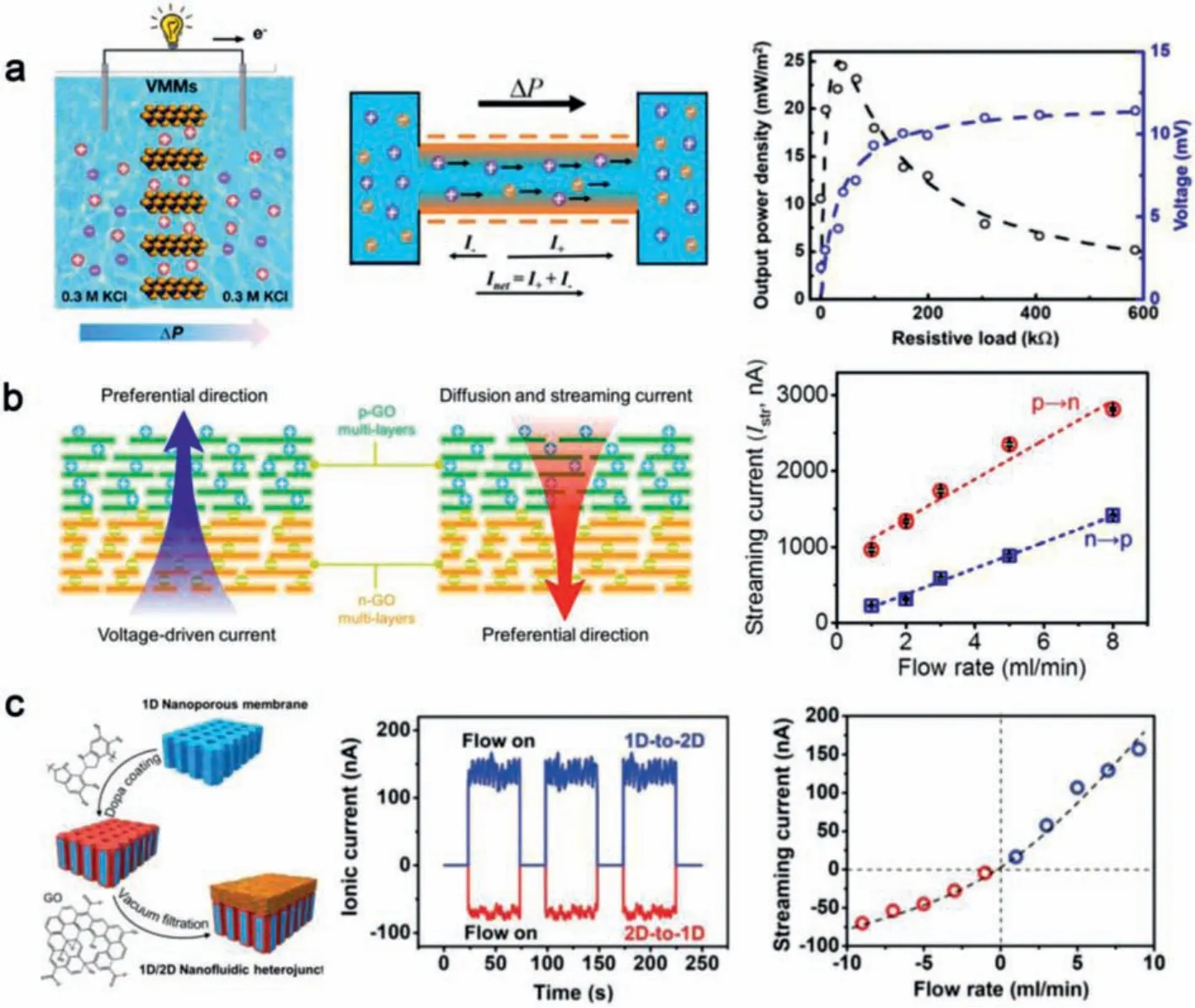
Fig.9.(a) Vertically oriented MXene membrane for electrokinetic energy conversion.Reproduced with permission [74].Copyright 2020, American Chemical Society.(b)Asymmetric charged GO multilayers for electrokinetic energy conversion.Reproduced with permission [128].Copyright 2019, American Chemical Society.(c) 1D/2D hybrid membrane for electrokinetic energy conversion.Reproduced with permission [129].Copyright 2019, John Wiley & Sons.
3.2.3.Photovoltaic energy conversion
Living organisms can convert solar energy into their own usable energy.The conversion and utilization of solar energy are mainly through some of the protons from low concentration to high concentration and then generating electrochemical potential.Bacteriophodopsin, a protein that absorbs light and carries protons across the cell membrane, utilizes light to drive protons to move across the cell membrane, moving protons against the charge gradient to the outside of the cell to carry more positive charges, creating a charge gradient that can be used to drive cell activity.Bionic nanochannels have been used for photovoltaic energy conversion like bacteriophodopsin [130,131].Moreover, 2D materials perform an essential task in the aforementioned field.
BN is a class of tremendous photocatalysts and semiconductors with remarkable light absorption capability.Xiaoet al.reported a novel strategy on the basis of the carbon nitride nanotube-based membranes which possess the capability of driving ions thermodynamically uphill against an up to 5000-fold concentration gradient through illumination [49].The separation of holes and electrons in the membranes by illumination leads to a transmembrane potential which is considered to be the infrastructure for the pumping phenomena.The system can generate a stable open-circuit voltage of 550 mV and a current density of 2.4 μA/cm2when collecting solar energy (Fig.10a).Guoet al.prepared a layered GO membrane capable of generating ion migration under asymmetric light [132].Under this asymmetrical illumination, ions can migrate over a wide concentration range at much faster rates than simple diffusion, creating a concentration gradient (Fig.10b).They described that the irradiation of light diminishes the local electric potentials on the GOM according to the mechanism of carrier diffusion.By implementing illumination to an off-center position, an electric potential difference is formed that is able to drive the transport of ionic species.
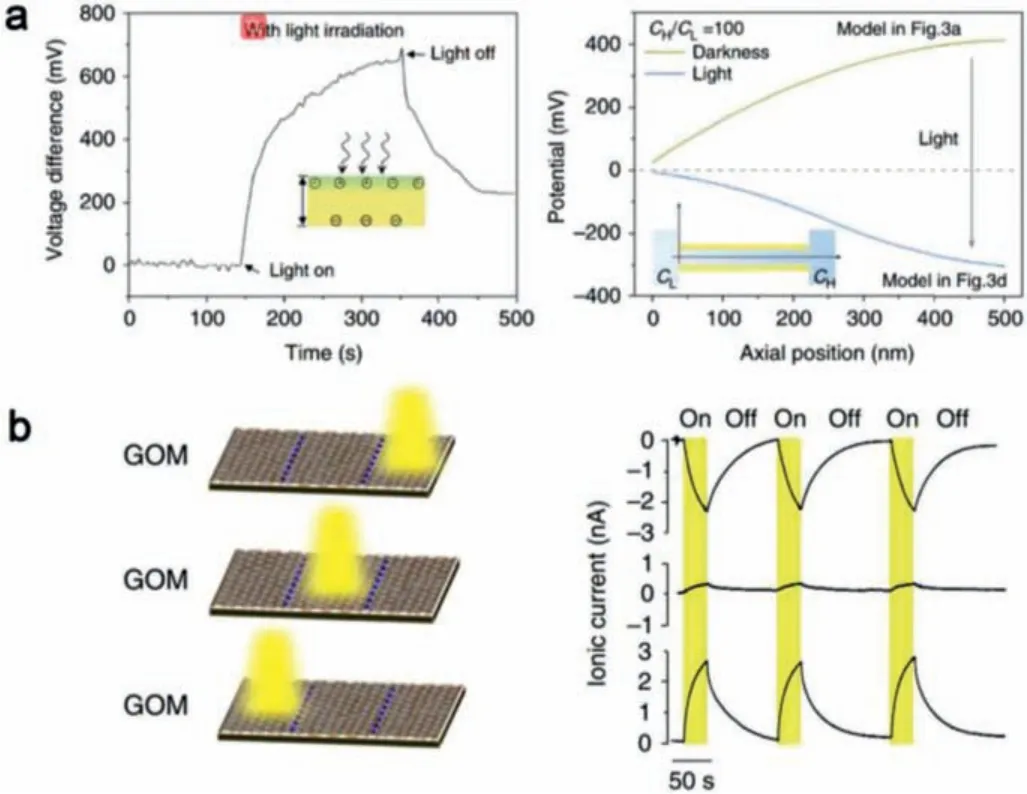
Fig.10.(a) Carbon nitride nanotube membrane for photovoltaic energy conversion.Reproduced with permission [49].Copyright 2019, Springer Nature.(b) Layered GO membrane generates ion migration under asymmetric light.Reproduced with permission [132].Copyright 2019, Springer Nature.
As clean and sustainable energy, light energy has great potential in solid nanoradiation systems, and the conversion efficiency of photoelectric energy also needs to be further improved.
4.Conclusion
Inspired by biological ion channels and the layered macrostructure of nacre, bioinspired nanochannels based on 2D materials have received considerable attention and illustrated the remarkable potential for nanodevice research and applications.This review summarizes the recent research progress in the construction and application of biologically nanochannels based on 2D materials.
Of the construction of bioinspired nanochannels based on 2D materials, we introduced the layered materials of these nanochannels, the construction strategies, and the property of nanochannels based on 2D materials.The layered materials of bioinspired nanochannels based on 2D materials including mono-elemental 2D materials (graphene, BP), excessive metallic chalcogenides (MoS2,ReS2), layered silicate materials (MMT, kaolin), and other new 2D materials (MXene, C3N4) are listed.These 2D materials can be used for constructing nanochannels by various facile methods including vacuum filtration, pressure-assisted filtration, Wet-spinning assembly, CVD, transmission electron microscopy drilling techniques, and so forth.Depending on the specific application of nanochannels,different materials and methods are required and definitely, the characteristics of the nanochannels obtained by different preparation methods are also distinct.Further, various directions such as single nanopore and nanotube, vertical and horizontal layered nanochannels can be achieved from 2D materials, which can provide more possibilities for the application of bioinspired nanochannels.
A wide spectrum of applications can be designed for nanochannels according to their physical or chemical properties that can be altered by external stimulus.Since 2D materials have layerdependent properties and abundant optical band gaps, they have unique optical properties and can be applied in light-responsive devices and photovoltaic energy conversion.Besides, they have been widely used in salinity gradient energy conversion and electrokinetic energy conversion based on the interaction of double electric layers in nanochannels.2D nanochannel material is a hot topic in the research of nanofluidic devices.Besides these applications, it has great potential in thermoelectric conversion and magnetoelectric conversion.The optical, electrical, and mechanical properties of 2D nanochannels could be combined with nanofluid devices to provide new possibilities for the efficient conversion and utilization of new energy in the future.In addition, there is still a need to improve the stability of membranes based on materials and the efficiency of energy conversion.The high performance of ion channels in living organisms provides inspiration for the preparation of efficient ion transport membrane, such as the introduction of asymmetric structures.However, asymmetric ion transport in 2D nanofluid systems have not been widely developed.Attention should be paid to the construction of asymmetric biochannels based on 2D materials, such as introducing asymmetric factors like charge, dimension, material and others.Besides, the preparation of high-quality and large surface area 2D nanochannel materials is also a challenge.
Declaration of competing interest
The authors declare that they have no known competing financial interests or personal relationships that could have appeared to influence the work reported in this paper.
Acknowledgments
The work was supported by the National Natural Science Foundation of China (No.22005162), the Natural Science Foundation of Shandong Province (No.ZR2020QE093), the China Postdoctoral Science Foundation (No.2019M652319) and the Special Financial Aid to Post-doctor Research Fellow (No.2020T130330).
 Chinese Chemical Letters2022年5期
Chinese Chemical Letters2022年5期
- Chinese Chemical Letters的其它文章
- Recent advances in enhancing reactive oxygen species based chemodynamic therapy
- An integrative review on the applications of 3D printing in the field of in vitro diagnostics
- Recent developments of droplets-based microfluidics for bacterial analysis
- Dynamics and biological relevance of epigenetic N6-methyladenine DNA modification in eukaryotic cells
- Recent progress in advanced core-shell metal-based catalysts for electrochemical carbon dioxide reduction
- Recent advances in carbon-based materials for electrochemical CO2 reduction reaction
